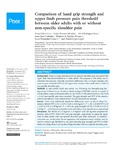Mostrar o rexistro simple do ítem
Comparison of Hand Grip Strength and Upper Limb Pressure Pain Threshold Between Older Adults With or Without Non-specific Shoulder Pain
| dc.contributor.author | López-López, Daniel | |
| dc.contributor.author | Calvo-Lobo, César | |
| dc.contributor.author | Rodríguez Sanz, David | |
| dc.contributor.author | Romero Morales, Carlos | |
| dc.contributor.author | Sanz Corbalán, Irene | |
| dc.contributor.author | Sánchez Romero, Eleuterio A. | |
| dc.contributor.author | Fernández-Carnero, Josué | |
| dc.date.accessioned | 2022-02-10T10:59:09Z | |
| dc.date.available | 2022-02-10T10:59:09Z | |
| dc.date.issued | 2017-02 | |
| dc.identifier.citation | Calvo Lobo C, Romero Morales C, Rodríguez Sanz D, Sanz Corbalán I, Sánchez Romero EA, Fernández Carnero J, López López D. 2017. Comparison of hand grip strength and upper limb pressure pain threshold between older adults with or without non-specific shoulder pain. PeerJ 5:e2995 https://doi.org/10.7717/peerj.2995 | es_ES |
| dc.identifier.uri | http://hdl.handle.net/2183/29756 | |
| dc.description.abstract | [Abstract] Background There is a high prevalence of non-specific shoulder pain associated with upper limb functional limitations in older adults. The purpose of this study was to determine the minimal clinically important differences (MCID) of grip strength and pressure pain threshold (PPT) in the upper limb between older adults with or without non-specific shoulder pain. Methods A case-control study was carried out following the Strengthening the Reporting of Observational Studies in Epidemiology (STROBE) criteria. A sample of 132 shoulders (mean ± SD years) with (n = 66; 76.04 ± 7.58) and without (n = 66; 75.05 ± 6.26) non-specific pain were recruited. The grip strength and PPT of the anterior deltoid and extensor carpi radialis brevis (ECRB) muscles were assessed. Results There were statistically significant differences (mean ± SD; P-value) for anterior deltoid PPT (2.51 ± 0.69 vs 3.68 ± 0.65, kg/cm2; P < .001), ECRB PPT (2.20 ± 0.60 vs 3.35 ± 0.38 kg/cm2; P < .001) and grip strength (20.78 ± 10.94 vs 24.63 ± 9.38 kg; P = .032) between shoulders with and without non-specific pain, respectively. Discussion The MCID of 1.17 kg/cm2, 1.15 kg/cm2 and 3.84 kg were proposed for anterior deltoid PPT, ECRB PPT and grip strength, respectively, to assess the upper limb of older adults with non-specific shoulder pain after treatment. In addition, univariate and multivariate (linear regression and regression trees) analyses may be used to consider age distribution, sex, pain intensity, grip strength and PPT in older adults including clinical and epidemiological studies with non-specific shoulder pain. | es_ES |
| dc.language.iso | eng | es_ES |
| dc.publisher | PeerJ | es_ES |
| dc.relation.uri | https://doi.org/10.7717/peerj.2995 | |
| dc.rights | Atribución 4.0 Internacional | es_ES |
| dc.rights.uri | http://creativecommons.org/licenses/by/4.0/ | * |
| dc.subject | Shoulder pain | es_ES |
| dc.subject | Dolor en el hombro | es_ES |
| dc.subject | Myofascial Pain Syndrome | es_ES |
| dc.subject | Síndrome de dolor miofascial | es_ES |
| dc.subject | Referred pain | es_ES |
| dc.subject | Dolor referido | es_ES |
| dc.subject | Aged | es_ES |
| dc.subject | Ancianos | es_ES |
| dc.subject | Trigger points | es_ES |
| dc.subject | Puntos de activación | es_ES |
| dc.subject | Hand Strength | es_ES |
| dc.subject | Fuerza en la mano | es_ES |
| dc.title | Comparison of Hand Grip Strength and Upper Limb Pressure Pain Threshold Between Older Adults With or Without Non-specific Shoulder Pain | es_ES |
| dc.type | info:eu-repo/semantics/article | es_ES |
| dc.rights.access | info:eu-repo/semantics/openAccess | es_ES |
| UDC.journalTitle | PeerJ | es_ES |
| UDC.volume | 5 | es_ES |
| UDC.startPage | 2995 | es_ES |
| dc.identifier.doi | 10.7717/peerj.2995 |
Ficheiros no ítem
Este ítem aparece na(s) seguinte(s) colección(s)
-
GI-UDISAP - Artigos [194]






